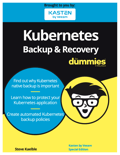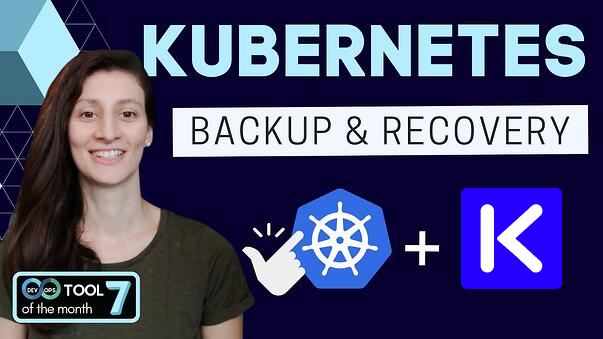Extending VMware vSAN 7 with Kasten K10 for cloud native backup, recovery & mobility
In case you haven’t heard, VMware and Kasten have been working together for several years now to provide data management for Kubernetes and cloud native apps. VMware is well-known for virtualization and cloud computing software, and for offering a range of products and solutions for data centers and cloud environments.
When it comes to modern applications, VMware recognizes the need for storage solutions that are optimized for the requirements of these applications, which often include cloud native architectures, microservices, containers, and orchestration frameworks like Kubernetes.
VMware has been actively working on integrating storage technologies with its virtualization and containerization platforms to provide comprehensive solutions for modern applications. With the introduction of vSAN 7, the company has extended and enhanced its cloud native storage capabilities to allow containerized applications to deploy and use file-level persistent storage. Additionally, persistent volumes are now able to support the use of encryption and snapshots. With the release of vSphere 7.0, VMware now provides virtual volumes (vVOLs) support as well.
All of these integrations are critical to the benefits provided by vSphere Add-on for Kubernetes (formerly known as Project Pacific), VMware’s initiative to allow customers to build, run and manage modern, cloud native applications on Kubernetes, in vSphere.
Compared to earlier versions of vSAN, the CNS capabilities in vSAN 7 enable:
- File persistent volumes (Read Write Many, or RWM)
- Persistent volume encryption
- Persistent volume resizing (in offline mode)
- Support of vVOLS (limited to basic vVOL creation)
SPBM versus Tagging
Storage Policy Based Management (SPBM) of persistent volumes for containers is preferable to using tagging in vSphere, because with SPBM, volumes can be changed. Inherent to Kubernetes, storage classes cannot be changed on a persistent volume. Tagging using vSphere can only influence initial placement, not ongoing changes. As a result, SPBM offers superior flexibility.
VMware has responded by offering a modern app platform that supports cloud native apps on vSphere by extending the existing vSphere platform to manage and operate Kubernetes apps. Now users can leverage vCenter workflows with the following components:
- CNS Platform: This is the vCenter integrated storage infrastructure layer to support block and file persistent volumes required by modern apps.
- Cloud-Native Storage: vSAN 7 integrates with Kubernetes and offers native support for developing containerized applications using VMware's Tanzu Kubernetes Grid.
- CSI Driver: This is a K8s storage driver that orchestrates storage requests from within K8s apps on vSphere vSAN 7.
- vDPP: The vSAN Data Persistence platform (vDPP) operator is a framework responsible for running and managing partner stateful services integrated with vSphere. It exposes available stateful services to the vSphere administrator.
- Data Protection and Disaster Recovery for VM Workloads: vSAN 7 includes built-in data protection and disaster recovery features. It supports various data protection mechanisms like snapshots, clones and RAID configurations, and integrates with VMware Site Recovery Manager (SRM) to enable replication and failover for business continuity purposes.
Enhanced data management with Kasten K10
As a VMware design partner for data management, Kasten K10 can be seamlessly deployed with vSAN 7 to enhance its inherent data protection capabilities. And while VMware SRM can help you and your organization protect more traditional VM workloads, Kasten K10 can protect your cloud native applications deployed on vSphere with Tanzu.
Here are some of the ways Kasten K10 can be used in conjunction with VMware vSAN 7:
- Policy-defined Backups: Kasten allows you to define backup policies, capture application-consistent snapshots, and store the backup data on different storage targets, including vSAN for your Kubernetes workloads.
- Persistent Volume Management: Kubernetes applications often require persistent storage volumes for their data. vSAN 7, as a storage solution, can provide the underlying storage for these persistent volumes, and Kasten can help manage the lifecycle of those volumes, including provisioning, cloning and snapshotting.
- Disaster Recovery: By creating backups of Kubernetes applications, Kasten K10 enables the restoration of application data and configurations in the event of a disaster. These backups can be stored on vSAN 7 or other storage targets, and can be used to recover the Kubernetes applications in another environment.
By integrating Kasten K10 with VMware vSAN 7, your organization can benefit from application-aware data management, advanced data protection and workload portability, along with multi-cloud support and enhanced automation. In this way, you can optimize your containerized application deployments on vSAN, ensuring data availability and recoverability, while streamlining data management.
Kasten K10 is available on the VMware Cloud Marketplace. New to Kasten K10? Try it for free!
Posted in:
EcosystemShare
Recent Posts
How to Eliminate Day 2 Challenges of Deploying Kubernetes with OpenShift + IBM Cloud with Kasten K10
Kubernetes Ransomware: 2-Step Protection for Kubernetes Applications
10 Key Takeaways from Kubernetes Backup & Recovery For Dummies
Kubernetes Security with Kasten K10 V5.0
What is Instant Recovery in Kasten K10 by Veeam?
All Categories
Backup Data Management Disaster Recovery Data Protection Community Partners/Ecosystem
Matt brings over 15 years of experience to his role as Principal Solutions Architect at Kasten. He has a background in cloud computing, DevSecOps, and IT infrastructure, including cloud infrastructure, virtualization, infrastructure-as-code (IaC), and web application development. Matt is passionate about learning, leveraging, and building open-source technology software projects both at work and in his free time.
Download Free Kasten K10
For information about Kasten K10
Contact Us
For information about Kasten K10, please send us a message using the form on this page, or email us at contact@kasten.io
For product support: Open a case via Veeam
Community support: Veeam Community
Address:
Kasten, Inc.
8800 Lyra Drive, Suite 450
Columbus, Ohio 43240
We value the critical role that the security community plays in helping us protect the confidentiality, integrity, and availability of our software, services, and information. If you have information about security vulnerabilities that affect Kasten software, services, or information, please report it to us via our HackerOne Vulnerability Disclosure Program, or anonymously via this form.


